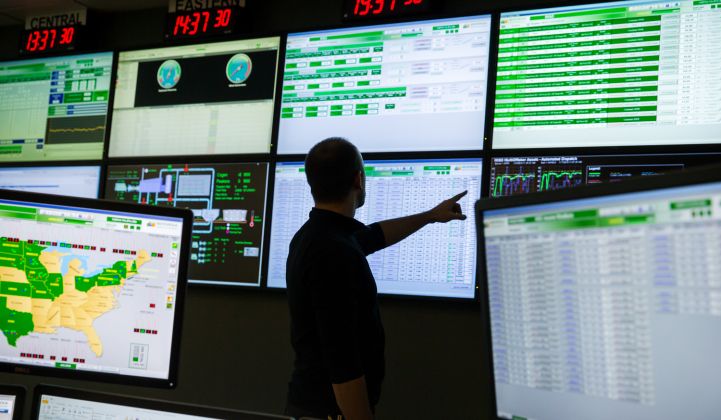Avangrid, the U.S. utility group and renewables developer, has withdrawn its long-term guidance for the 2018-2022 period due to disruptions from the coronavirus pandemic and permitting delays.
Avangrid, which is publicly listed but majority-owned by Spain's Iberdrola, reported a higher profit in the first quarter of 2020, driven by an improved performance from its 7.5-gigawatt onshore wind power fleet.
The Connecticut-based company reported first-quarter consolidated net income of $236 million, or $0.76 per share, compared to $219 million, or $0.71 per share, in the same quarter last year. That’s a significant uptick from its less-than-stellar performance in 2019, when earnings dropped modestly.
In a Wednesday conference call, CEO James Torgerson credited the improved performance to better wind production from its huge base of existing U.S. renewables capacity, including 831 megawatts of onshore wind built last year by its Oregon-based Avangrid Renewables subsidiary. Avangrid is the third-largest U.S. wind power producer behind Berkshire Hathaway Energy and NextEra Energy, according to the American Wind Energy Association.
Despite the coronavirus pandemic, Avangrid remains on track to complete 908 megawatts of onshore wind and repowering projects this year, and it is maintaining essential operations at its utilities, Torgerson said.
Renewables net income grew to $52 million in the first quarter compared to $4 million in the same quarter last year. That more than compensated for a slight fall in income from its Avangrid Networks subsidiary of eight utilities serving 3.25 million customers in New York and New England.
CEO Torgerson set to retire
Like many U.S. utilities, Avangrid has pledged to suspend disconnections and late fees for customers unable to pay their bills due to sickness or job losses and suspended all non-emergency work in customers’ homes. Many of its employees are doing their jobs from home, and a smaller number are unable to work as they care for sick relatives, the CEO said.
Those impacts didn't have much impact on first-quarter results. Even so, Torgerson, who announced plans to retire in June earlier this year, said Avangrid “will be closely monitoring and addressing the potential COVID-19 risks,” such as potential impacts on energy demand and on prices for the 21 percent of its renewables generation open to fluctuations in energy market prices as merchant generation.
Avangrid delayed its annual investors day until the fourth quarter of 2020 to account for COVID-19 disruptions, which include delayed rate cases for New York utilities and uncertainty over the financial impact to its utilities.
“Considering this postponement and several assumptions that have changed since our current long-term guidance was introduced in early 2019, we are withdrawing our long-term guidance for the 2018-2022 period, as well as the supporting assumptions, until we provide a new long-term outlook later this year," the company said.
Unclear outlook for Vineyard Wind, offshore projects
Among the uncertainties facing Avangrid is when it will be able to complete its $2.8 billion Vineyard Wind project off the shore of Massachusetts. Avangrid and joint owner Copenhagen Infrastructure Partners had planned Vineyard’s two 400-megawatt phases to come online in 2021 and 2022 to become the first completed U.S. offshore wind farms.
But last year the U.S. Bureau of Ocean Energy Management announced it would delay its environmental review of the project to late 2019 or early 2020, and earlier this year pushed that deadline out further to the end of 2020. With the delay, Vineyard Wind won’t be able to be completed until 2023 at the earliest.
Alejandro de Hoz, president of Avangrid Renewables, declined to provide an anticipated completion date for the Vineyard project on Wednesday’s call. But he confirmed that it will be eligible for the stepped-down 18 percent Investment Tax Credit if it is completed in 2023 or 2024.
Vineyard Wind’s next major offshore wind project, the 804-megawatt Park City project, is expected to be built by 2025. Torgerson said the company is still negotiating a final contract with Connecticut’s two electric utilities, after beating out rival development groups backed by Ørsted and Shell in December.
Force majeure at onshore projects
For its onshore wind projects under construction, Avangrid has received some force majeure notices from turbine suppliers indicating they may not be able to deliver on schedule later this year, meaning “there is a risk of delay," said CFO Doug Stuver. But the company expects to finish all of its onshore wind projects on schedule, with construction continuing with social distancing and separation of work crews, he said.
Like much of the U.S. wind industry, Avangrid is asking the U.S. Treasury Department for a one-year extension of the safe harbor provision of the federal Production Tax Credit for projects started in 2016, to avoid the possibility of projects being downgraded to a lower tax-credit status, he added.
Avangrid is also hoping that the $950 million New England Clean Energy Connect transmission project planned by subsidiary Central Maine Power to carry Canadian hydropower and wind resources to Massachusetts, will be able to secure its final state permits and win a court challenge to a Maine ballot referendum that could block it, Torgerson said.




